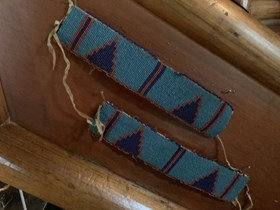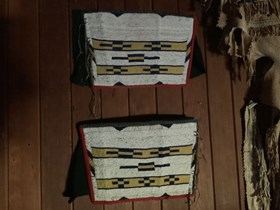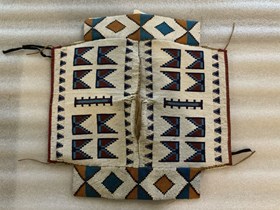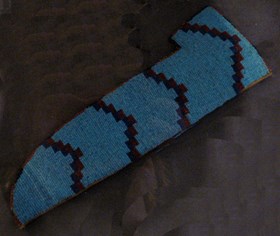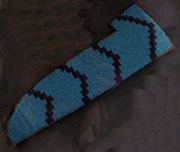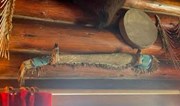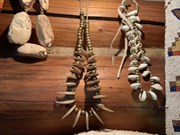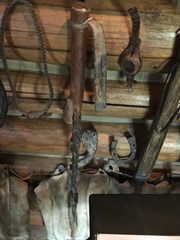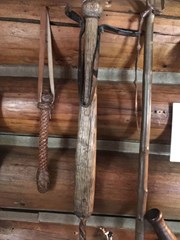Narrow Results By
White and Curren families papers and photographs
https://archives.whyte.org/en/permalink/descriptions830
- Part Of
- Peter and Catharine Whyte fonds
- Scope & Content
- Series consists of the following series: A. Dave White Sr. papers, 1887- 1942; B. Annie White papers, 1875-1955; C. Dave (Jack) White papers, 1911- 1955; D. Clifford White notebook, ca.1915; E. John D. Curren papers, 1886- 1940; F. White-Curren family photographs, 1885-1953. Papers consist of pers…
- Date Range
- 1869 - 1958
- Reference Code
- M36 / S37 / V683 / III
- Description Level
- 2 / Sous-fonds
- Part Of
- Peter and Catharine Whyte fonds
- Description Level
- 2 / Sous-fonds
- Fonds Number
- M36 / V683 / S37
- Series
- III. White and Curren families
- Sous-Fonds
- V683
- Accession Number
- 3069
- Reference Code
- M36 / S37 / V683 / III
- Date Range
- 1869 - 1958
- Physical Description
- ca. 2 m of textual records (and 36 oversize items). -- ca.3100 photographs (ca.1800 negatives, ca.1300 prints, 5 albums of ca.400 prints).
- History / Biographical
- The White and Curren families of Banff, Alberta were the maternal and fraternal relatives of Peter Whyte. Dave McIntosh White, 1864- 1940, Peter Whyte's father, came to the Canadian Rockies in 1885 with the Canadian Pacific Railway. In 1894 he opened a general merchandise business, the Park Store, in Banff. The success of this business resulted in expansions in 1908-1909 and in 1912-1913. For a short time, Whyte operated a similiar business in Bankhead. White was a long-time friend of the Stoney Nakoda, Annie (Curren) White, 1879-1955, emigrated to Canada from Scotland with her father, John Donaldson Curren, and a brother in 1886. They settled in Anthracite, east of Banff, where J. D. Curren operated a small coal mining business. Annie Curren married Dave White in 1901. Their children, all born in Banff, were Clifford, 1902-1964, Lila, 1903-1961, Peter, 1905-1966, and Dave Jr. (Jackie), 1908-1961. Clifford and Jack worked for the family business, Dave White and Sons.
- Scope & Content
- Series consists of the following series: A. Dave White Sr. papers, 1887- 1942; B. Annie White papers, 1875-1955; C. Dave (Jack) White papers, 1911- 1955; D. Clifford White notebook, ca.1915; E. John D. Curren papers, 1886- 1940; F. White-Curren family photographs, 1885-1953. Papers consist of personal, legal and financial papers; and records of Dave White, General Merchant, Dave White and Sons and White and Bayne Store. Pertains to Stoney Nakoda First Nations, Banff Indian Days, Highland gatherings, buildings, churches, skiing, coal and coal mines and Lake Minnewanka. Photographs consist largely of negatives and prints produced by various members of the White family, including Dave, Annie, Clifford and Jack White, pertaining to the White family members, travels, activities; the Banff-Lake Louise area; Banff events, places and people; winter sports; social events and friends, 1910- 1953, and glass negatives by J. D. Curren pertaining to Curren and White families and activities, Mount Assiniboine pack trip and Bow Valley scenes; ca.1885-1905. Also includes collected prints of family and friends, family businesses and buildings and winter sports, and albums pertaining to White and Curren families, 1885-1919 and Clifford White photographs, 1917-1921.
- Subject Access
- Banff V
- Banff - Events V
- Banff National Park
- CURREN FAMILY
- Stoney Nakoda First Nations
- White, Annie M
- White, Clifford Sr.
- WHITE, DAVE SR.
- White, Jack (Dave White Jr.)
- WHITE FAMILY
- Access Restrictions
- Access to photographs requires permission in advance from the Head Archivist.
- Finding Aid
- Series-level outline available. Electronic database available. Photographs are described at the sub-series level only (printed inventory provides more detail than the computer inventory).
- Related Material
- Consitutes Sous-fonds III of the Peter and Catharine Whyte fonds.
- Title Source
- Title based on contents of file
- Content Details
- Forms part of Sous-fonds III of the Peter and Catharine Whyte fonds. Photographs in this section begin with the early family portraits of David McIntosh White taken in New Brunswick and those of Annie Curren White taken in Scotland. The earliest negatives attributable to David and Annie White date ca.1908, or approximately the time they moved to their new home between Lynx Street and Bow Avenue. Most of the negatives from the first two decades of family photography are sized 8.3 x 11 cms., with the exception of what appears to be occasional experimentation with other formats, such as vest pocket and 4 x 5 Graflex, and images generated by other family members, such as J.D. Curren and the White children. This body of photography was undoubtedly initiated through the acquisition of a roll film camera on or about 1908. Judging from subject arrangement and other evidence, including shadow images of the photographer, most White family photography is attributable to Annie Curren White. There are several photographs from the collection showing her holding a camera or photographing family members, while no such photographs exist of Dave White. There can be little doubt, however, that Dave White participated in the photographic process, particularly in the period from 1910 to 1917, when there are numerous photographs of Annie and the children. On family motor trips, which began around 1917 and lasted until ca.1923, Dave and Annie's son Clifford appears to have shared photographic responsibilities. From this period on, Clifford and Annie, either one or the other, are the only family members who do not appear in group photographs. From this it is assumed that Dave White played a very minor roll as family photographer after 1918. Photographs attributable to Peter Whyte begin to appear around 1920, but most of his photography appears to be more personal than of a family record variety. None of the photographs in the early part of the collection have been attributed to Lila or Jack (Dave Jr.) White. After 1923, the point when the White children were grown and beginning to move away from home, Annie White becomes the primary family photographer. In the late 1920s she appears to have experimented with a Graflex camera for a time, but by 1930 had returned to a smaller format roll film camera. She continued to take numerous family photographs, usually group poses of her children and grandchildren, after Dave White's death in 1940 until shortly before her own passing in 1955. Also included in this section of the collection are a number of personal photographs generated by Clifford and Jackie (Dave Jr.) White. Around 1918, Clifford appears to have acquired his own camera which produced a 3 x 5 inch negative, and from that period until ca.1923, he produced many images of activities shared with friends and brothers, including a number of photographs of early ski tours and ski jumping in the Banff area. One album bears Clifford's initials on nearly all photographs, and these images match with many of the 3 x 5 inch negatives found elsewhere in the collection. Photographs attributed to Jackie (Dave Jr.) date from the late 1940s and early 1950s and may have entered the collection prior to the death of Annie White. Much of the dating of this collection from 1908 to 1920 was done by estimating the ages of various White children. Beyond that, the usual techniques were utilized, i.e. identification and dates noted on prints by family members, the depiction of specific historical events, changes in physical and cultural features, model dating of automobiles, reading of license plates, etc.
- Processing Status
- Processed
This material is presented as originally created; it may contain outdated cultural descriptions and
potentially offensive content.
Read more.
- Date
- 1880
- Material
- skin; glass
- Catalogue Number
- 103.01.0019 a,b
- Description
- A pair of beaded leather armlets. The design on each armlet is a turquoise background with vertical stripes and two stepped triangular shapes done in dark blue and red beads. There is scalloped beadwork around the edges, and thong ties at each end.
1 image
- Title
- Beaded Armbands
- Date
- 1880
- Material
- skin; glass
- Dimensions
- 29.0 cm
- Description
- A pair of beaded leather armlets. The design on each armlet is a turquoise background with vertical stripes and two stepped triangular shapes done in dark blue and red beads. There is scalloped beadwork around the edges, and thong ties at each end.
- Subject
- Stoney Nakoda
- beadwork
- crafts
- decorative
- indigenous
- Credit
- Gift of Pearl Evelyn Moore, Banff, 1979
- Catalogue Number
- 103.01.0019 a,b
Images
This material is presented as originally created; it may contain outdated cultural descriptions and
potentially offensive content.
Read more.
- Date
- 1880 – 1900
- Material
- skin; fibre, cotton; glass
- Catalogue Number
- 103.05.0004 a,b
- Description
- A pair of beaded leggings with a flap of cotton fabric. These leggings tie around the legs with thongs. The design of the legging beadwork is of two yellow stripes containing a motif which is repeated in blue beads between the stripes on a white background.
1 image
- Title
- Beaded Leggings
- Date
- 1880 – 1900
- Material
- skin; fibre, cotton; glass
- Dimensions
- 36.0 x 44.0 cm
- Description
- A pair of beaded leggings with a flap of cotton fabric. These leggings tie around the legs with thongs. The design of the legging beadwork is of two yellow stripes containing a motif which is repeated in blue beads between the stripes on a white background.
- Subject
- Indigenous
- Stoney
- beadwork
- decorative
- regalia
- Blackfoot?
- Credit
- Gift of Pearl Evelyn Moore, Banff, 1979
- Catalogue Number
- 103.05.0004 a,b
Images
This material is presented as originally created; it may contain outdated cultural descriptions and
potentially offensive content.
Read more.
- Date
- 1880 – 1910
- Material
- skin, deer; fibre; glass
- Catalogue Number
- 103.05.0013
- Description
- A very short, completely beaded, tabard with beaded strips sewn to each shoulder forming cap sleeves. Each side of the jacket is beaded with a white background containing four large red and blue square figures with V-shaped “staircase” in the middle, on either side of central vertical bar of the s…
1 image
- Title
- Beaded Jacket
- Date
- 1880 – 1910
- Material
- skin, deer; fibre; glass
- Dimensions
- 51.5 x 25.3 cm
- Description
- A very short, completely beaded, tabard with beaded strips sewn to each shoulder forming cap sleeves. Each side of the jacket is beaded with a white background containing four large red and blue square figures with V-shaped “staircase” in the middle, on either side of central vertical bar of the same red adn blues. A series of small read and blue stepped triangles from a band a the top and bottom of the bodice. The beads are worked on canvas which is rolled at the neck to form edging, and edged with red fabric at the bottom. Short bead strips are sewn to each shoulder, and each has a design of two large white diamond shapes around a blue diamond and a yellow ochre diamond, with a horizontally divided background in the blue and yellow ochre colour. The diamond shapes are outlined with black and red glass beads. Short buckskin thongs tie the tabard together at the corners under the arms.
- Subject
- Indigenous
- Stoney
- Plains
- Cree
- ceremonial
- children
- beadwork
- regalia
- Credit
- Gift of Pearl Evelyn Moore, Banff, 1979
- Catalogue Number
- 103.05.0013
Images
This material is presented as originally created; it may contain outdated cultural descriptions and
potentially offensive content.
Read more.
- Date
- 1880 – 1910
- Material
- stone; wood; skin; metal; hair, buffalo; feather, eagle; sinew
- Catalogue Number
- 104.06.0004
- Description
- A war club/pony club made of an oval-shaped stone attached to a leather-covered stick handle with a leather strap. The leather strap has a tuft of eagle down at its end. The end of the handle has a leather loop with a bunch of long dark bison hair tied together at one end.
1 image
- Title
- Club
- Date
- 1880 – 1910
- Material
- stone; wood; skin; metal; hair, buffalo; feather, eagle; sinew
- Dimensions
- 55.0 cm
- Description
- A war club/pony club made of an oval-shaped stone attached to a leather-covered stick handle with a leather strap. The leather strap has a tuft of eagle down at its end. The end of the handle has a leather loop with a bunch of long dark bison hair tied together at one end.
- Subject
- Indigenous
- Stoney
- military
- Credit
- Gift of Pearl Evelyn Moore, Banff, 1979
- Catalogue Number
- 104.06.0004
Images
This material is presented as originally created; it may contain outdated cultural descriptions and
potentially offensive content.
Read more.
- Date
- 1885 – 1920
- Material
- skin; glass
- Catalogue Number
- 104.10.0003
- Description
- A very simply shaped sheath made to hold a knife. The back of the sheath is plain moosehide with a large belt loop at the centre made from a 3 cm wide strip of hide. Part of the top of the case that extends to one side. The front of the sheath is completely beaded with a light blue background and…
1 image
- Title
- Knife Sheath
- Date
- 1885 – 1920
- Material
- skin; glass
- Dimensions
- 7.5 x 31.0 cm
- Description
- A very simply shaped sheath made to hold a knife. The back of the sheath is plain moosehide with a large belt loop at the centre made from a 3 cm wide strip of hide. Part of the top of the case that extends to one side. The front of the sheath is completely beaded with a light blue background and four chevron shaped lines made up of small squares of red and dark blue beads. A rolled beaded edging of red and dark blue beads runs along the curved side and across the top of the sheath.
- Credit
- Gift of Pearl Evelyn Moore, Banff, 1979
- Catalogue Number
- 104.10.0003
Images
This material is presented as originally created; it may contain outdated cultural descriptions and
potentially offensive content.
Read more.
- Date
- 1880 – 1890
- Material
- skin, moose; skin, caribou; glass
- Catalogue Number
- 104.10.0005
- Description
- A moosehide sheath made to hold a rifle (small trapper's gun). There is a very short fringe of leather along one side and around the top. The case is decorated with beadwork of blue, yellow, white and red beads in three narrow bands at the bottom, and a wide band at the top made up of five rows of…
1 image
- Title
- Gun Case
- Date
- 1880 – 1890
- Material
- skin, moose; skin, caribou; glass
- Dimensions
- 100.0 cm
- Description
- A moosehide sheath made to hold a rifle (small trapper's gun). There is a very short fringe of leather along one side and around the top. The case is decorated with beadwork of blue, yellow, white and red beads in three narrow bands at the bottom, and a wide band at the top made up of five rows of beadwork.
- Credit
- Gift of Pearl Evelyn Moore, Banff, 1979
- Catalogue Number
- 104.10.0005
Images
This material is presented as originally created; it may contain outdated cultural descriptions and
potentially offensive content.
Read more.
Beaded Necklace
https://archives.whyte.org/en/permalink/artifact103.01.0008
- Date
- 1880 – 1900
- Material
- claws, cougar; metal, brass; skin
- Catalogue Number
- 103.01.0008
- Description
- A man's necklace made of cougar claws alternating with brass trade beads. This necklace would be tied around the neck with leather thongs.
1 image
- Title
- Beaded Necklace
- Date
- 1880 – 1900
- Material
- claws, cougar; metal, brass; skin
- Dimensions
- 45.0 cm
- Description
- A man's necklace made of cougar claws alternating with brass trade beads. This necklace would be tied around the neck with leather thongs.
- Subject
- Indigenous
- Stoney
- animals, cougar
- regalia
- Credit
- Gift of Pearl Evelyn Moore, Banff, 1979
- Catalogue Number
- 103.01.0008
Images
This material is presented as originally created; it may contain outdated cultural descriptions and
potentially offensive content.
Read more.
Quirt Riding Whip
https://archives.whyte.org/en/permalink/artifact106.06.0008
- Date
- 1880 – 1920
- Material
- wood; skin
- Catalogue Number
- 106.06.0008
- Description
- A handle carved from a straight tree branch with a leather wrist strap fastened around one end and through itself. The lash at the opposite end has two ends of a leather strap that are slit and woven through each other's slits with a braided effect. The handle is about 1/3 of the length, the la…
1 image
- Title
- Quirt Riding Whip
- Date
- 1880 – 1920
- Material
- wood; skin
- Dimensions
- 3.5 x 3.5 x 86.0 cm
- Description
- A handle carved from a straight tree branch with a leather wrist strap fastened around one end and through itself. The lash at the opposite end has two ends of a leather strap that are slit and woven through each other's slits with a braided effect. The handle is about 1/3 of the length, the lash about 2/3 of the length of the quirt.
- Credit
- Gift of Pearl Evelyn Moore, Banff, 1979
- Catalogue Number
- 106.06.0008
Images
This material is presented as originally created; it may contain outdated cultural descriptions and
potentially offensive content.
Read more.
Quirt Riding Whip
https://archives.whyte.org/en/permalink/artifact106.06.0009
- Date
- 1880 – 1920
- Material
- wood; skin
- Catalogue Number
- 106.06.0009
- Description
- A club-like wooden handle with a knob at end and leather thongs attached at the other end. The thongs are braided part way and then left loose (lash is slightly longer than handle). There is a leather thong wrist strap attached to the handle just below the knob.
1 image
- Title
- Quirt Riding Whip
- Date
- 1880 – 1920
- Material
- wood; skin
- Dimensions
- 112.0 cm
- Description
- A club-like wooden handle with a knob at end and leather thongs attached at the other end. The thongs are braided part way and then left loose (lash is slightly longer than handle). There is a leather thong wrist strap attached to the handle just below the knob.
- Credit
- Gift of Pearl Evelyn Moore, Banff, 1979
- Catalogue Number
- 106.06.0009
Images
This material is presented as originally created; it may contain outdated cultural descriptions and
potentially offensive content.
Read more.

